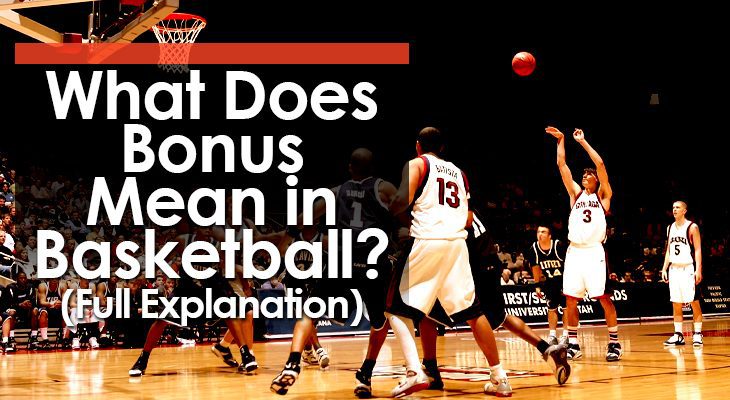

If you’ve ever been to a basketball game before, chances are you’ve noticed the word “Bonus” on the scoreboard along with arrows pointing in every direction.
But what exactly this word means on the court can be a bit confusing, as it occurs at different times at almost every level of basketball.
This article will discuss what the “Bonus” means in basketball, when it occurs at different levels of the sport, and how you can best use it on both ends of the court.
What is a bonus in basketball?
The bonus occurs when a team commits too many team fouls.
Once that happens, every subsequent defensive foul will put the other team in the penalty box and at the line to shoot free throws, whether they hit the shot or not.
This bonus will continue until it expires, at which point team violations will reset and start accumulating again.
You’ll often hear announcers say that a team has x number of “faults” before putting an opponent in the bonus, meaning they can make that mistake multiple times before putting them on the line for a regular foul.
It is important to note that bonus free throws are not awarded if there is a player-controlled foul, instead the team will simply get possession of the ball.
When does the bonus occur?
As mentioned earlier, the bonus occurs on a different number of fouls at almost every different level of basketball and can even result in a different number of free throws.
Men’s College Basketball.
For men’s college basketball, a team gets a bonus when their opponent commits the 7th foul of the half. At this point, they shoot 1 and 1, meaning if they make the first free throw, they get the second.
Then, when the opponent commits their 10th team foul of the half, it becomes a double bonus and the team gets 2 free throws for each foul, regardless of whether it is the first to go in or not.
Women’s college basketball and high school.
In the women’s college game, as well as in high school, the game is divided into quarters, so they have a slightly different approach to the bonus rule.
In these levels, a team receives a bonus for 5 team fouls per quarter, and instead of 1 and 1, they are immediately awarded 2 free throws.
Professional basketball.
Professional basketball has the same rules in that teams are awarded a bonus when the other team accumulates 5 team fouls.And again, they automatically get 2 free throws when the other team reaches this threshold.
However, they have a slightly different rule that applies at the end of quarters to limit the need for a trailing team to consistently foul to put the other team in the bonus.
When the clock reaches 2:00 left in either quarter, a team automatically scores a 2nd foul bonus in that period, whether or not they reach 5 team fouls in the entire quarter.
How to use the bonus to your advantage
Like each basketball rulethere are ways to make the most of the bonus within your offensive strategy.
1. Attack the Basket
The best way to foul your opponent is to drive the basketball aggressively to the rim and not just settle for jumpers.
If you want to consistently get your team into the bonus, your offense needs to include plenty of opportunities for your players to attack the basket off the dribble and look to make contact on the way to the rim.
And when your team reaches the bonus, be sure to run! set plays with some dribbles trying to make contact and get to the line.
One of the worst things you can do is get a bonus and then never shoot a free throw because your team stops attacking the basket.
2. Keep the ball with your best shooters
To get the most out of being in the bonus, it’s important that your best shooters are able to make as many free throws as possible.
So when your team is in the bonus, try to attack with your best foul shooters so they either get open looks or have a chance to get to the lane if fouled.
This is especially true late in the game when feeding the lead. Make sure your best players understand the importance of keeping the ball as much as possible.
3. Practice free throws
Getting to the foul line in the bonus is the first step.
However, making most of these free throws should be the goal.
No matter how hard you try to execute the above strategy, there will still be times when your less-than-innocuous shooters will step out of line.
Take advantage of the bonus situation to train them and your whole team, make sure you try the free throw.
But instead of just shooting them, make sure your players shoot them when they’re tired and also when there’s a consequence to make it as close to a game-like experience as possible.
Prevent your opponent from using the bonus
Otherwise, putting your opponent in a bonus can be a recipe for disaster because you’re giving them an easy scoring opportunity.Here are some ways you can protect your team from the bonus.
1. Learn how not to screw up
Just as we teach our defenders how to block or how to slide their feet, we must also teach and stress to them how not to foul when they are defending.
A great way to do this is to hold something in their hands (towel, noodle pool, etc.) while they block and protect the ball.
This will help them keep their hands off the driving player and instead work on stopping the ball with their chest, which is much less likely to be called than putting both hands on the attacking player.
2. Play Zone Defense
As stated before, one of the best ways to prevent fouls is to force the other team to stay outside and settle for jumpers.
And one of the best ways to achieve that is by playing zone defense.
(Don’t do this if you coach youth basketball)
Most zone attacks are much more stationary and depend on outside shots than human attacks.
So playing lane often results in fewer fouls from your team, which means your opponent is much less likely to get a bonus.
3. Eliminate silly violations
If your team understands the bonus and the consequences of screwing up after this point, it will hopefully prevent them from making bad decisions that put the opponent in lane unnecessarily.
Silly fouls like going for a steal or a rebound with little chance to get them and creating a layup in the process can stop the other team at the line, sometimes without the ball even going into the frontcourt.
So if your players understand that taking a smarter and more conservative approach to the penalty kill will help prevent the other team from scoring easy points at the line.
Conclusion.
The bonus can be a great way to score some easy points for your team if you know how to get to the lane and can hit some free throws.
But it can also be an unfortunate way to lose a game if your opponent is scoring too many unnecessary fouls at the line.
Make sure your players know how the bonus works so you can use it to your advantage in your next basketball game.


